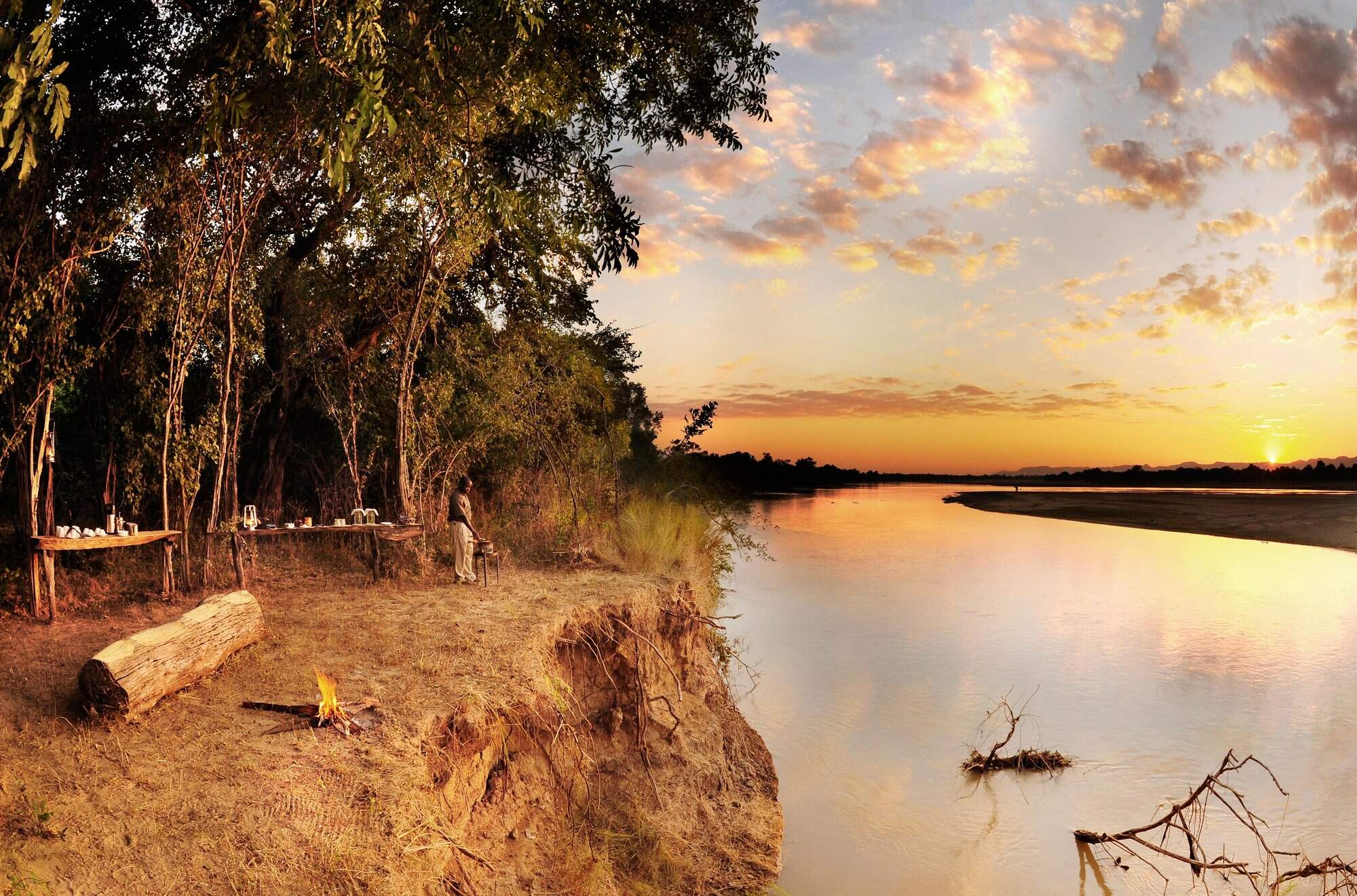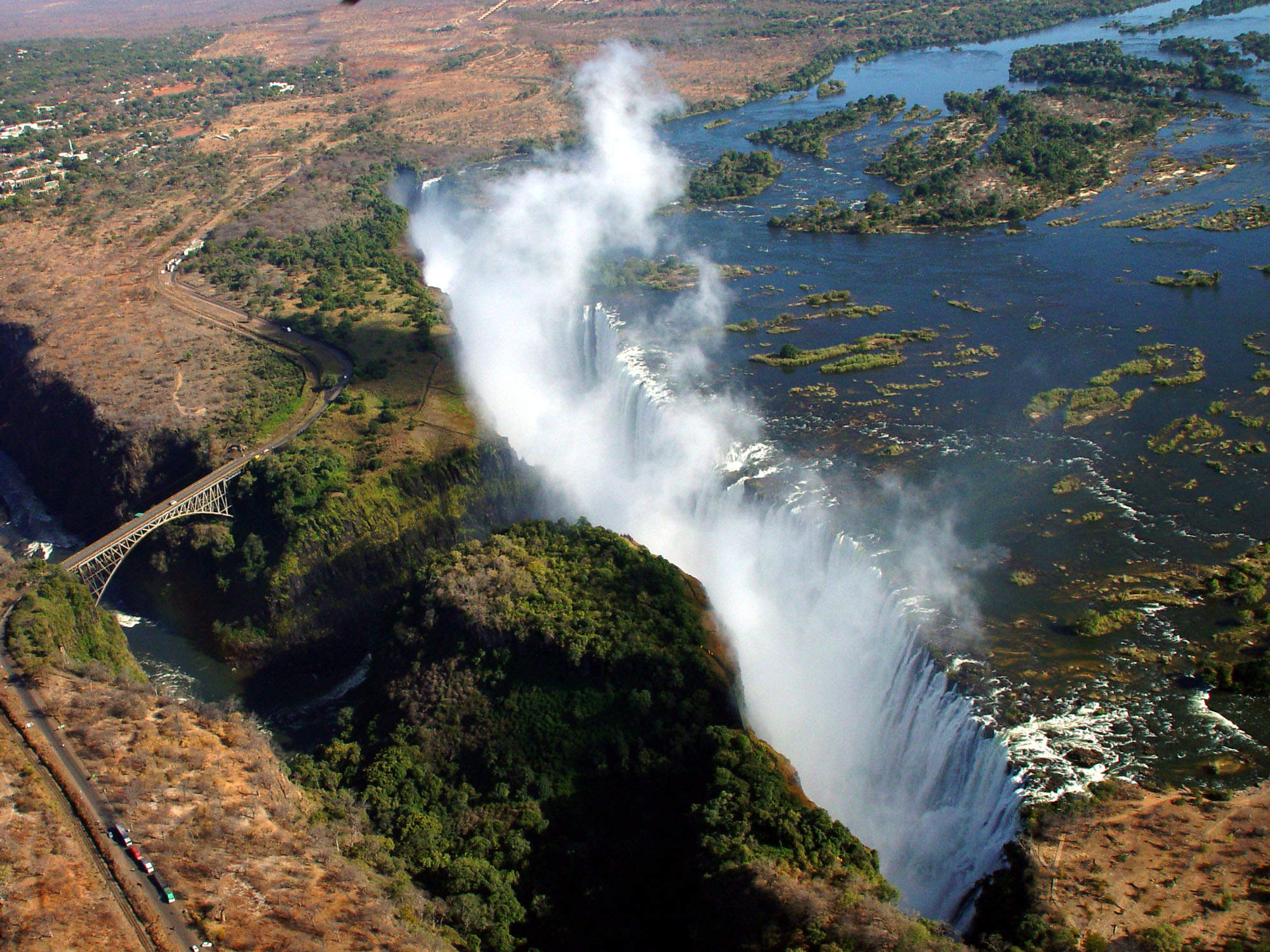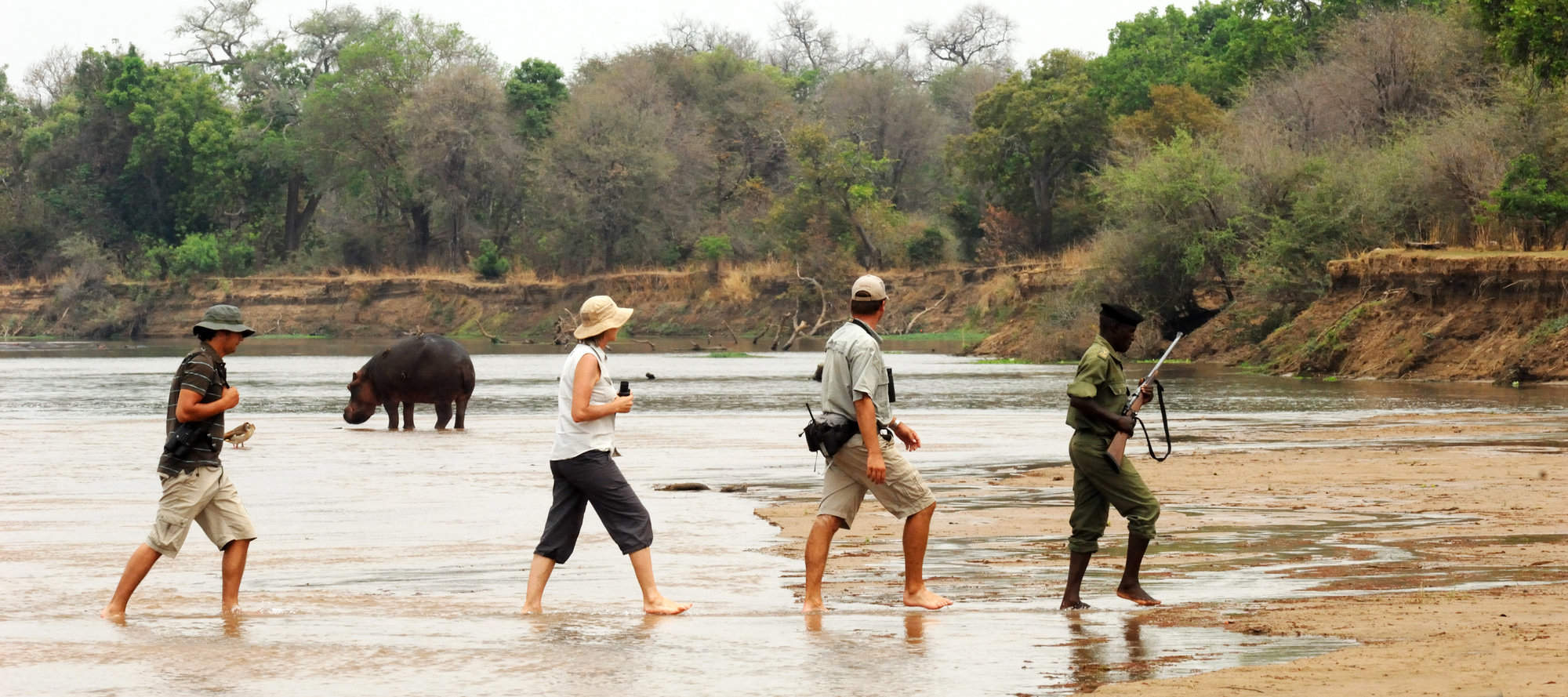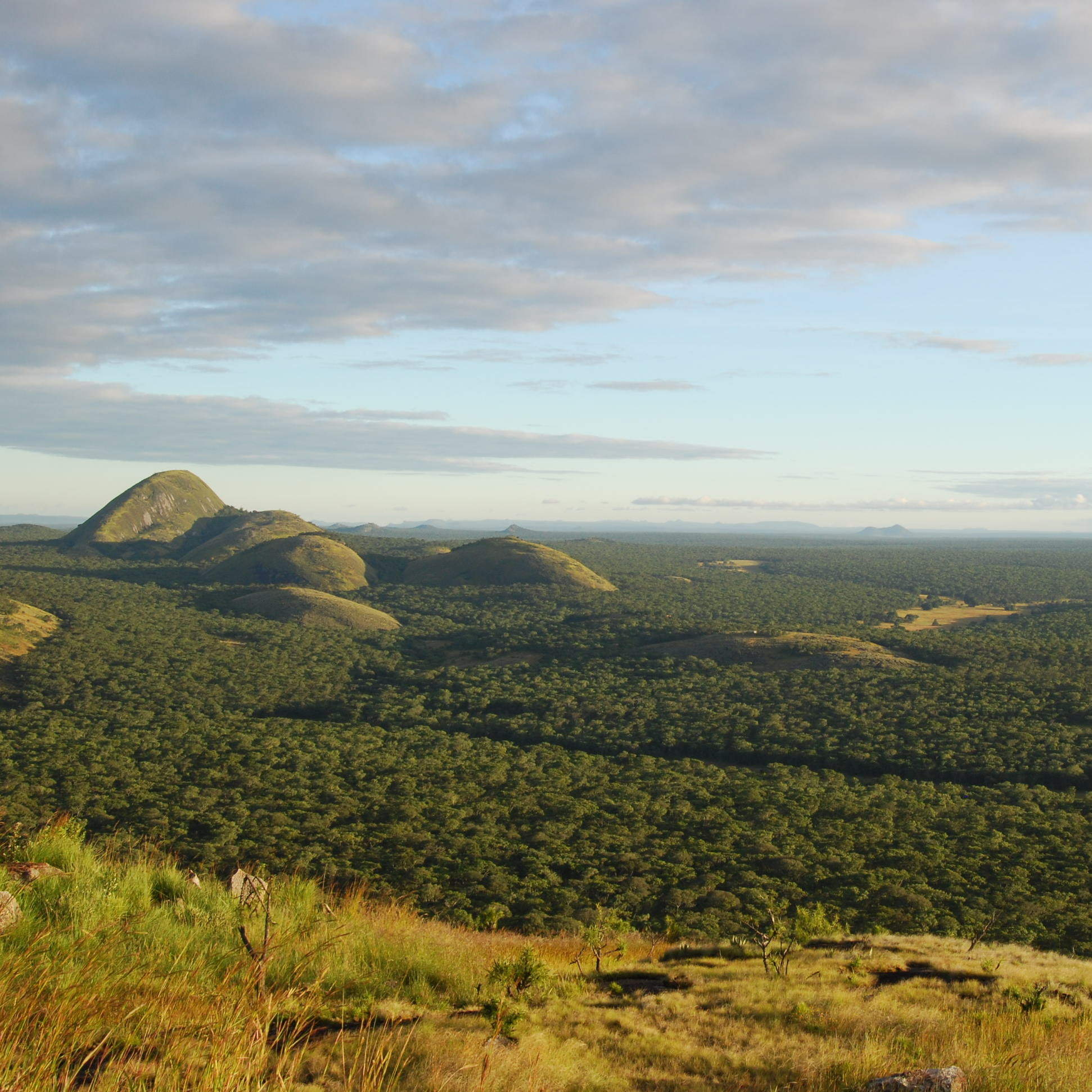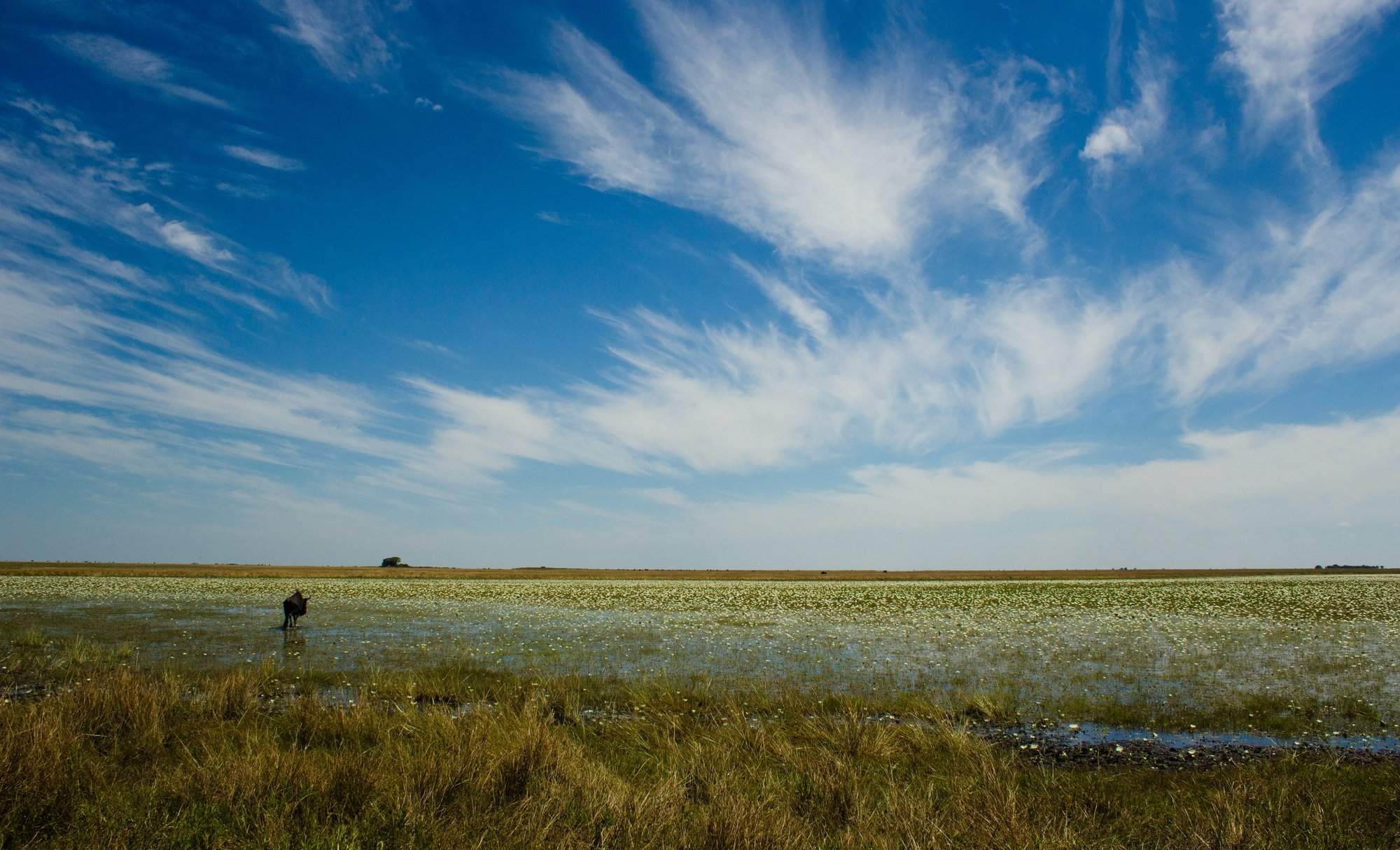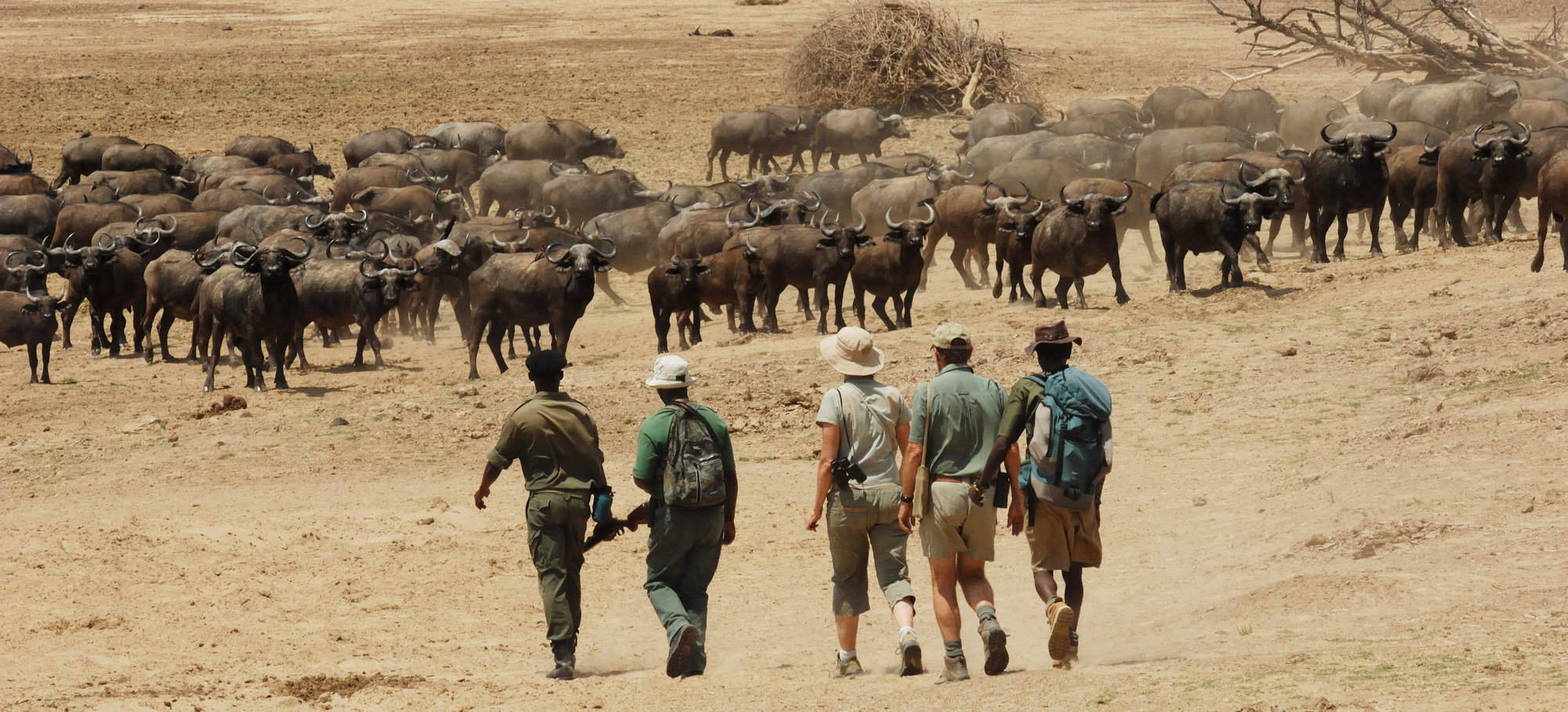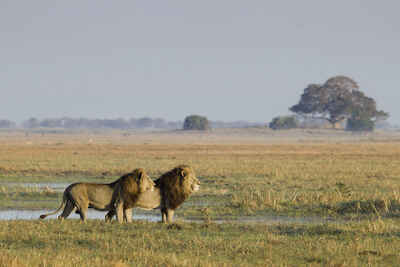
Kafue is Zambia's largest national park.
Explore Kafue's permanent rivers by boat...
Lions are widespread all over the park.
Leopards are common in the forest areas.
...or do a game drive that extends into the night.
Kafue National Park
Kafue National Park
Low on the radar of most visitors, yet populated with increasingly habituated wildlife, Kafue National Park is hugely underrated.
This is a national park on a grand scale, on a par sizewise with Wales or Vermont, and the largest of Zambia’s game parks. It is named after the Kafue River that forms part of its boundary as it flows towards the great Zambezi.
Falling within the park’s protection are so many diverse environments that it would be tempting to look no further than a Kafue National Park safari. Arguably the top choice is the tree-fringed area of Busanga Plains, teeming with wildlife in the dry season and a mecca for predators.
Where the Kafue River is widest, there are boat trips to be had, cruising silently between banks grazed by antelopes, the trees regularly munched by elephants on their way to or from their daily baths.
Then further south are the extensive Nanzhila Plains. For wildlife here, the perennial water of the Kafue is quite literally lifesaving. As the year progresses and the land dries up, even the deepest waterholes vanish and every blade of grass matters.
Welcoming visitors to this wilderness are just a handful of small, highly personal lodges, several of them still run by owners whose passion for Zambia’s Kafue National Park is lifelong. Others come on mobile safaris, guided by those whose knowledge and understanding of the area and its wildlife is born of years of experience. For this is a park to savour.
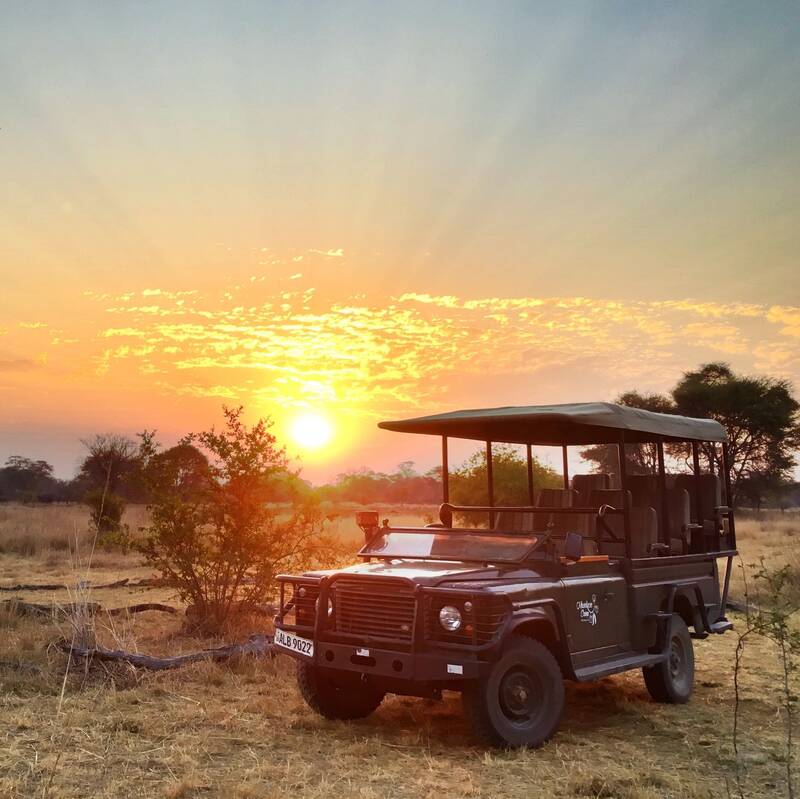
The best safaris visiting Kafue National Park
Choosing the best safari in Kafue National Park takes research, understanding and personal experience – and that’s where our Zambia team at Expert Africa excels.
Of course, the “best Kafue safari” depends on many factors. While seeing wildlife is a priority for almost everyone, the personality of those travelling, the style of accommodation and transport, the time of year, and of course the budget will have a big impact on that choice.
Given the size of Kafue National Park, spending a full week here is a great way to experience at least two contrasting habitats – without feeling rushed.
These could include the floodplains of the far north, where animals are increasingly drawn as the dry season progresses, and the riverine environment where the Kafue broadens as it flows further south.
These are just ideas, we'll always tailor-make a trip for you.
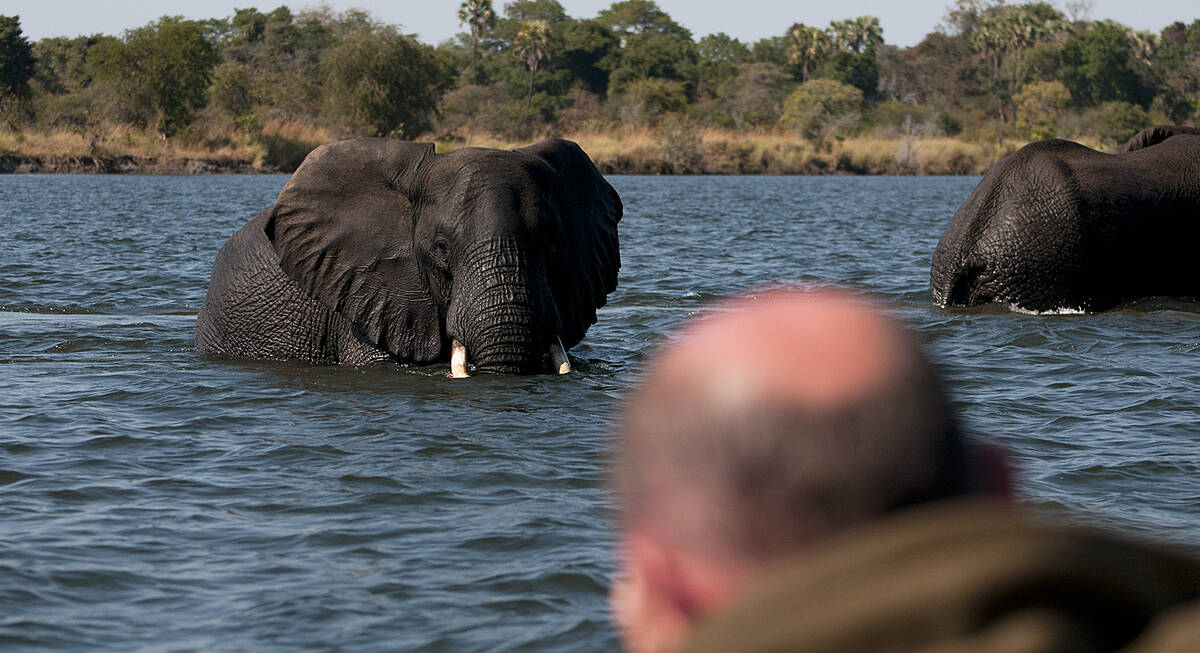
Defassa Waterbuck Safari
9 days • 3 locations
LUSAKA AIRPORT TO LUSAKA AIRPORT
Stay in three intimate, owner-run camps during this exploration of Kafue National Park. Remote locations, true wilderness and a range of activities make for a real adventure off the beaten track.
US$9,350 - US$9,360 per person
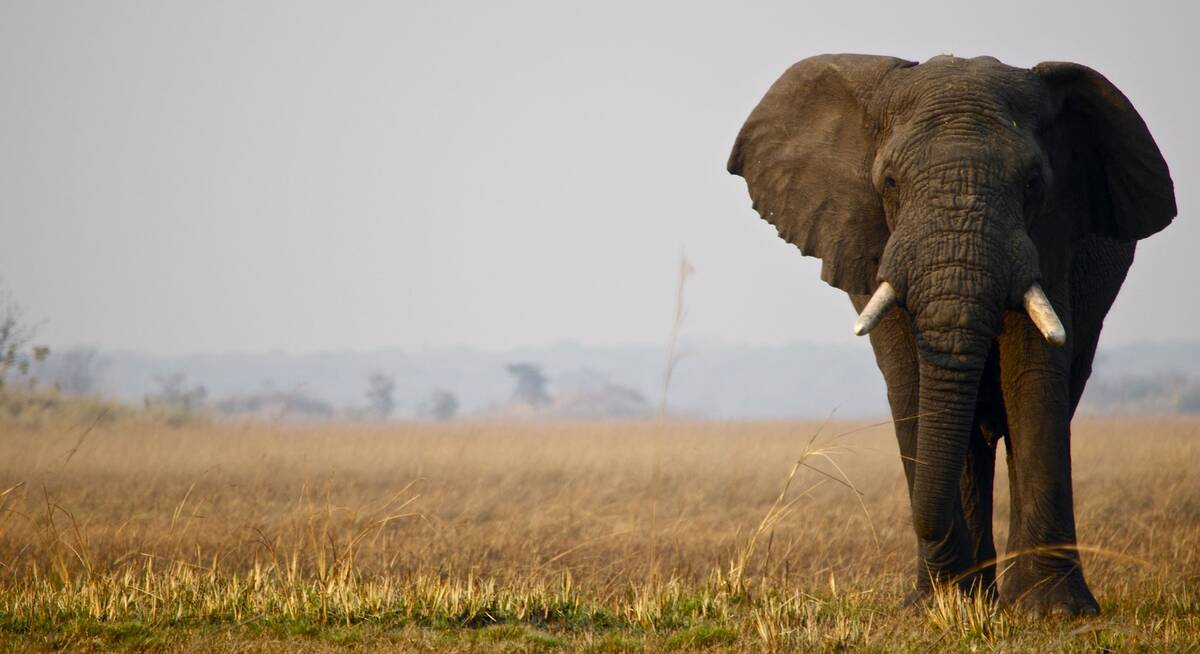
Purple Roller Safari
8 days • 2 locations
LUSAKA AIRPORT TO LUSAKA AIRPORT
Explore the varied habitats and terrain of Kafue National Park with stays in two wonderfully remote bushcamps: sister camps that offer access to both the centre of the park and the wildlife-rich Busanga Plains.
US$9,320 - US$9,320 per person
Most recent reviews of our safaris to Kafue
Feedback from our travellers is very important to us at Expert Africa. This is as important from those who have spent a holiday in Kafue National Park as in any of our destinations in Africa.
Not only do we welcome your comments, but they help to keep us fully up to date with any recent changes, and to inform future travellers, so helping them in their search for the right Kafue safari for them.
This feedback is also widely appreciated as genuine and accurate by our partners and lodges in Zambia, helping them to understand the views of their visitors.
Click below to browse all 75 reviews from Kafue National Park. All from our travellers; all are in full & unedited.
Arrived 4 Sep 2024, 14 nights
"Kafue and South Luangwa Sep 2024 "
Overall rating: Excellent
Arrived 30 Jul 2024, 18 nights
"Our Jul, Aug 2024 trip"
Overall rating: Excellent
Arrived 20 Jun 2024, 16 nights
"My Jun 2024 trip"
Overall rating: Excellent
Arrived 17 Oct 2023, 22 nights
"Our Oct 2023 trip"
Overall rating: Excellent
Arrived 8 Oct 2023, 13 nights
"My Oct 2023 trip"
Overall rating: Excellent
Arrived 5 Oct 2023, 28 nights
"Our Oct 2023 trip"
Overall rating: Excellent
Arrived 11 Sep 2023, 14 nights
"My Sep 2023 trip"
Overall rating: Excellent
Arrived 2 Sep 2023, 13 nights
"My Sep 2023 Zambia trip"
Overall rating: Excellent
Arrived 1 Sep 2023, 20 nights
"My Sep 2023 trip"
Overall rating: Excellent
Arrived 5 Aug 2023, 13 nights
"My Aug 2023 trip to Kafue & Lower Zambezi"
Overall rating: Excellent
Where to stay in Kafue
Places to stay in Kafue National Park are almost entirely small and intimate, dotted around the park from north to south, and underlining the sheer scale of this large reserve.
Common to most is a riverside location, from the Busanga Plains that spread out from the upper reaches of the Lufupa River – a tributary of the Kafue – and continuing south along the Kafue River as it gradually broadens towards Itezhi-Tezhi Dam.
Although some Kafue accommodation is in outlying areas, we recommend focusing on three areas of the park: the Busanga Plains, the central area, and perhaps the more remote southern area.
Selecting Kafue National Park lodges from each of these three areas enables visitors to experience the changing scenery and the impact that has on wildlife in each area.
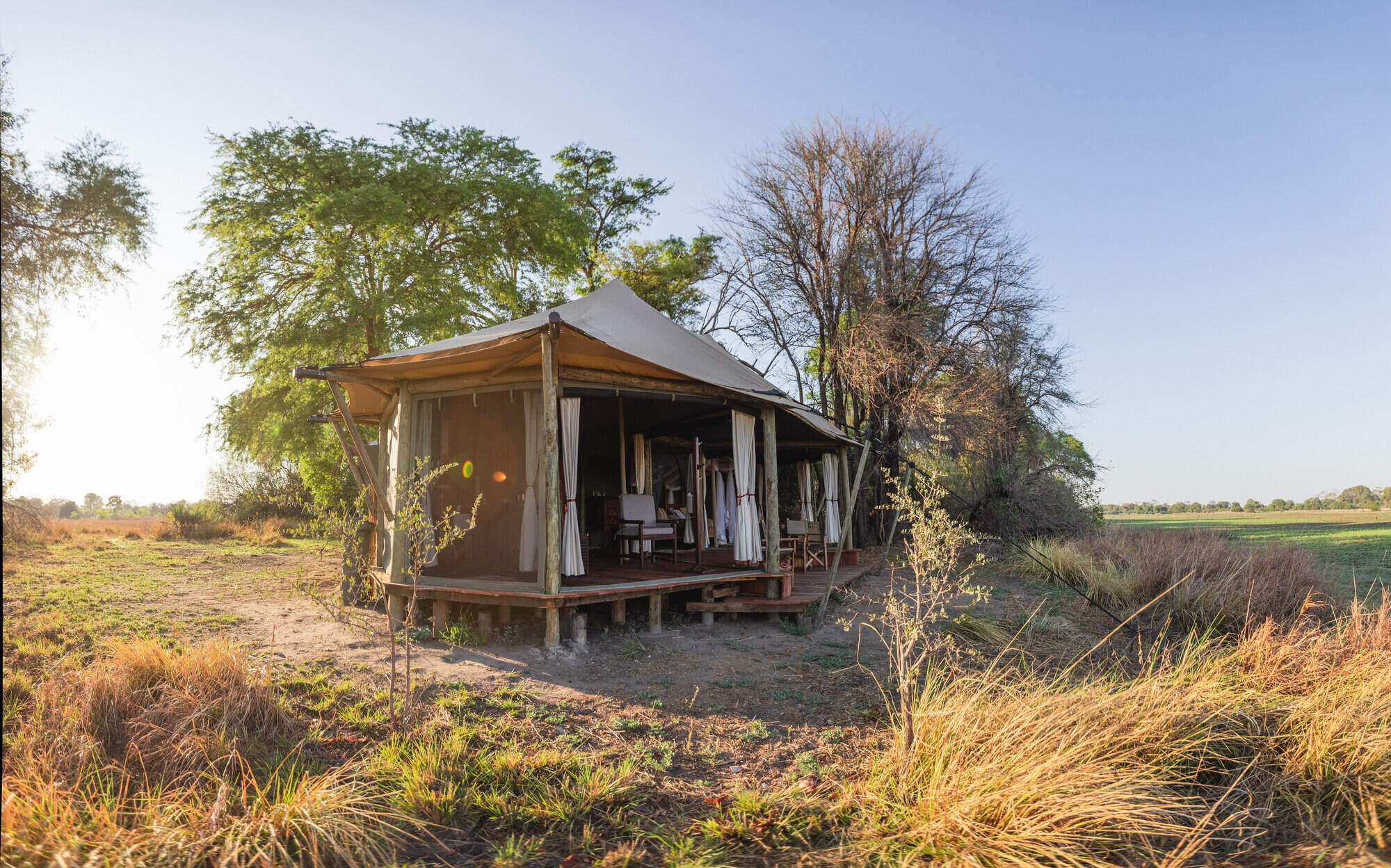
Musekese Camp
Musekese is a small owner-run tented camp, offering great guiding and a high degree of personal service in a stunning wilderness area, with modest game.
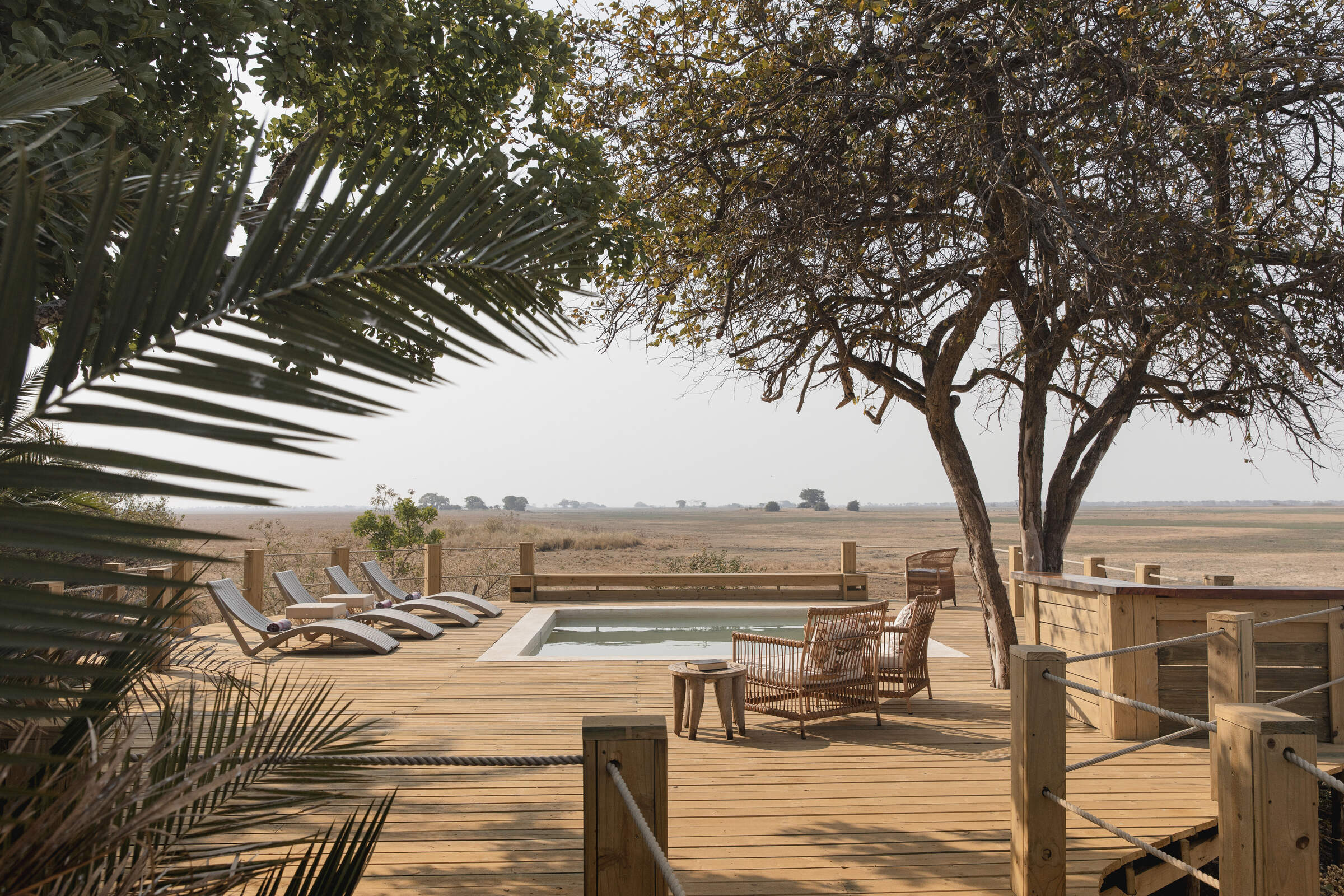
Busanga Bushcamp
Busanga Bushcamp is a small but comfortable tented bushcamp (max 8 guests) which makes a great base for a wildlife safari to the Busanga Plains.
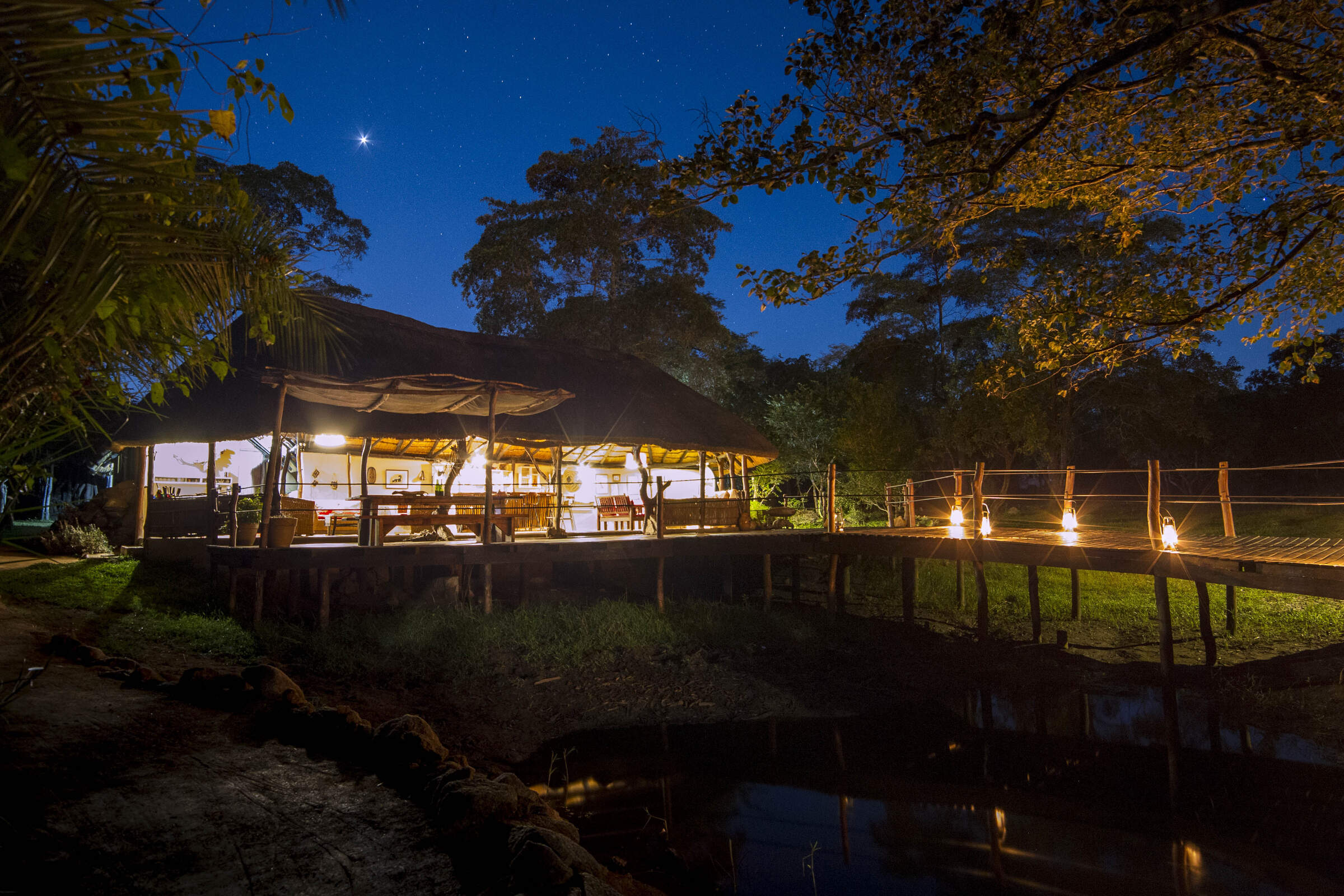
KaingU Lodge
KaingU Lodge, in the centre of the southern part of Zambia's vast Kafue National Park, is in a great location for exploring this section of the Kafue River
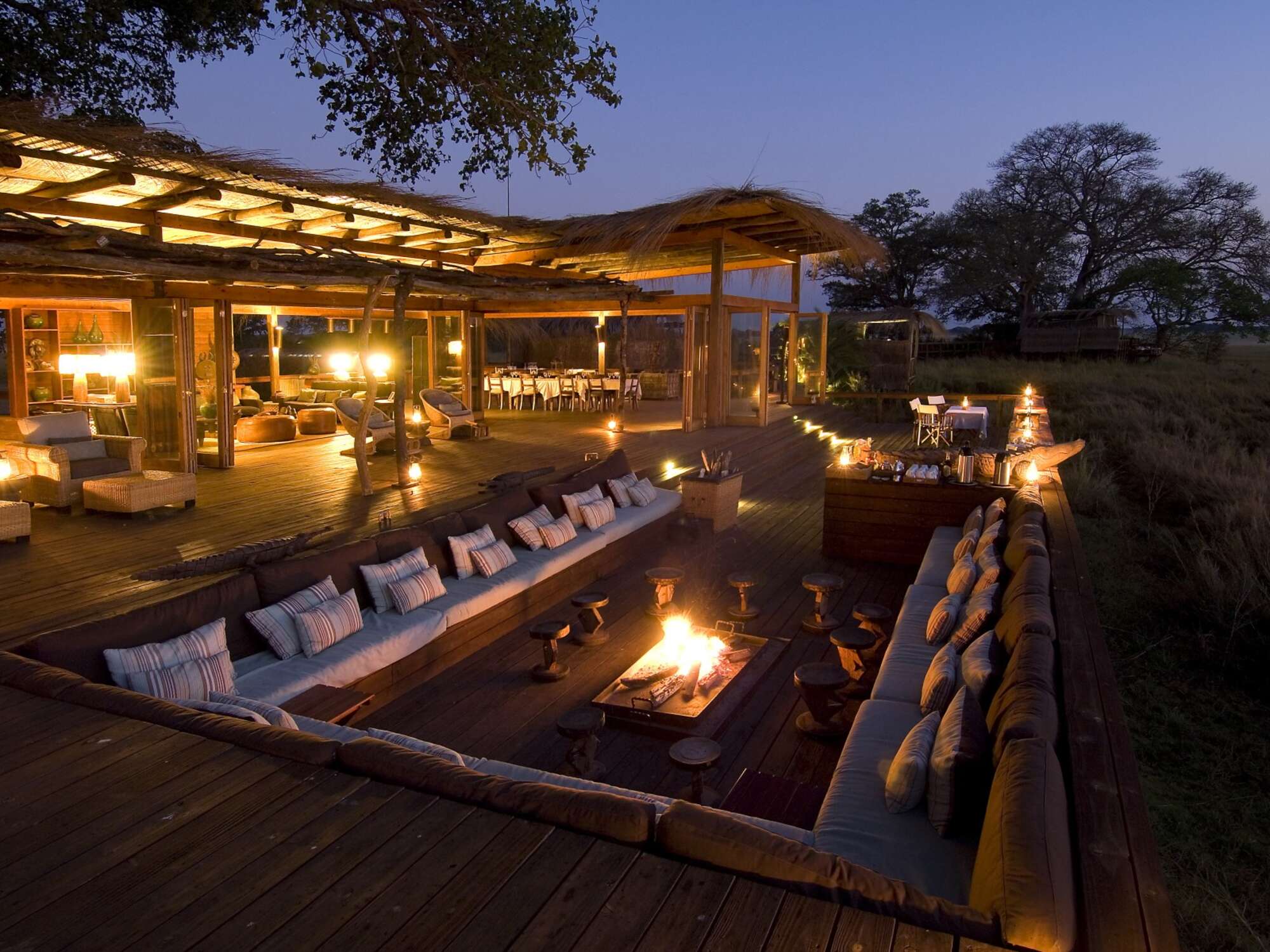
Shumba Camp
Shumba is a high-spec camp built on a tree island in the magical Busanga Plains. It opens in May, when the birdlife is particularly amazing; as the dry season progresses, the game can become remarkable.
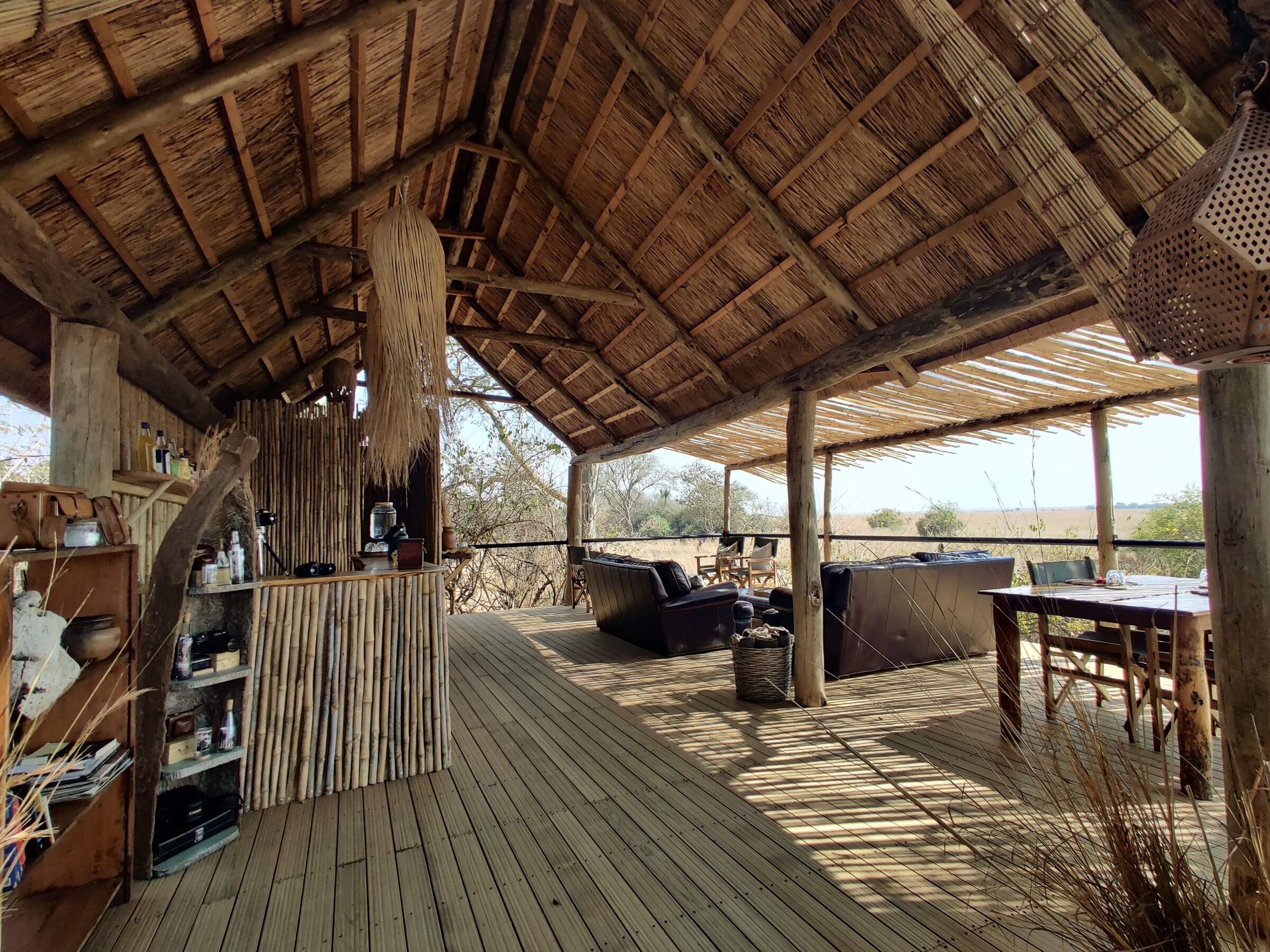
Ntemwa Busanga Camp
Ntemwa Busanga Camp is a simple but comfortable camp on the southern tip of the Busanga Plains which combines well with its sister camp, Musekese.
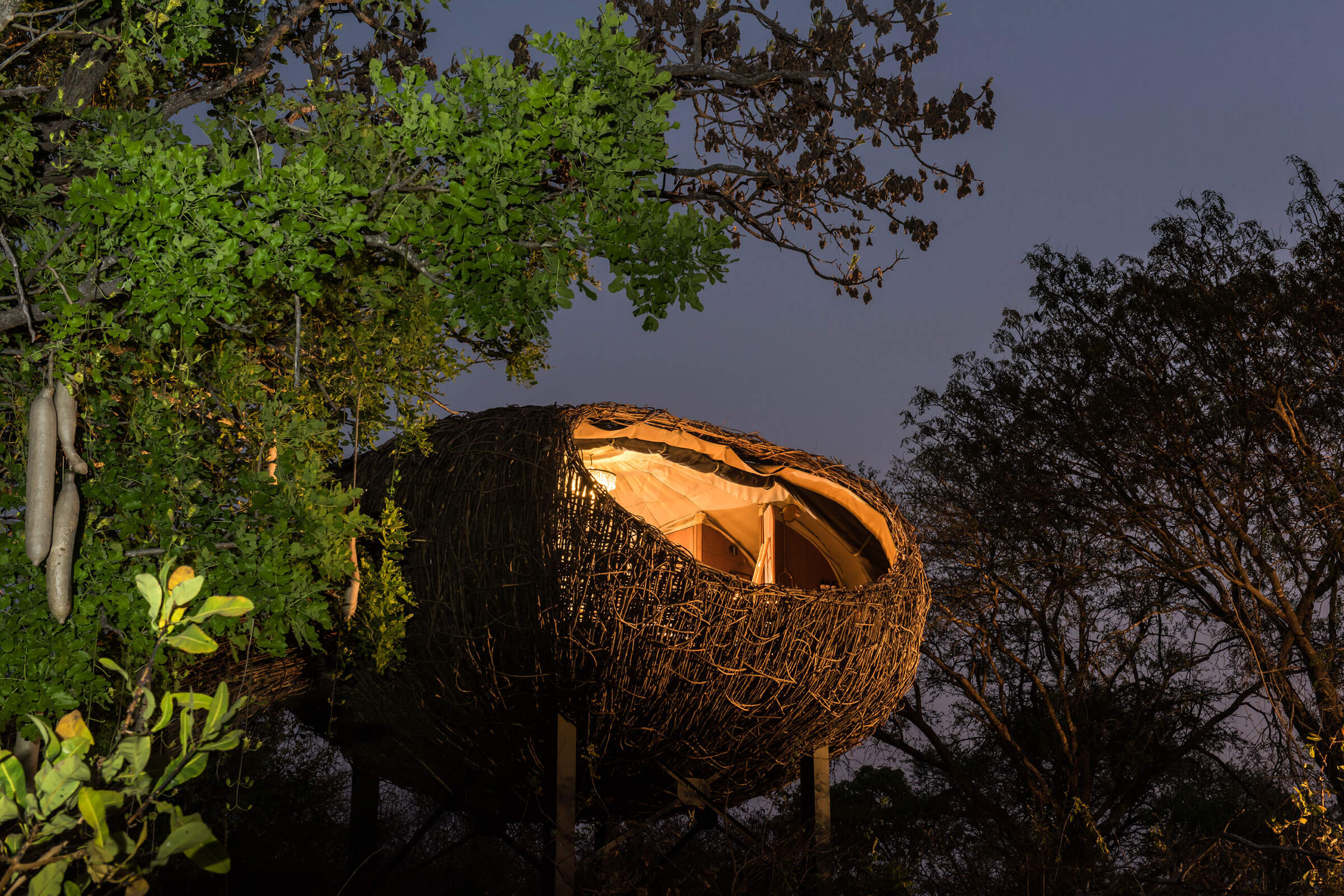
Chisa Busanga
Opened in mid 2021, Chisa Busanga Camp is a beautifully designed, small, intimate and rustic camp.
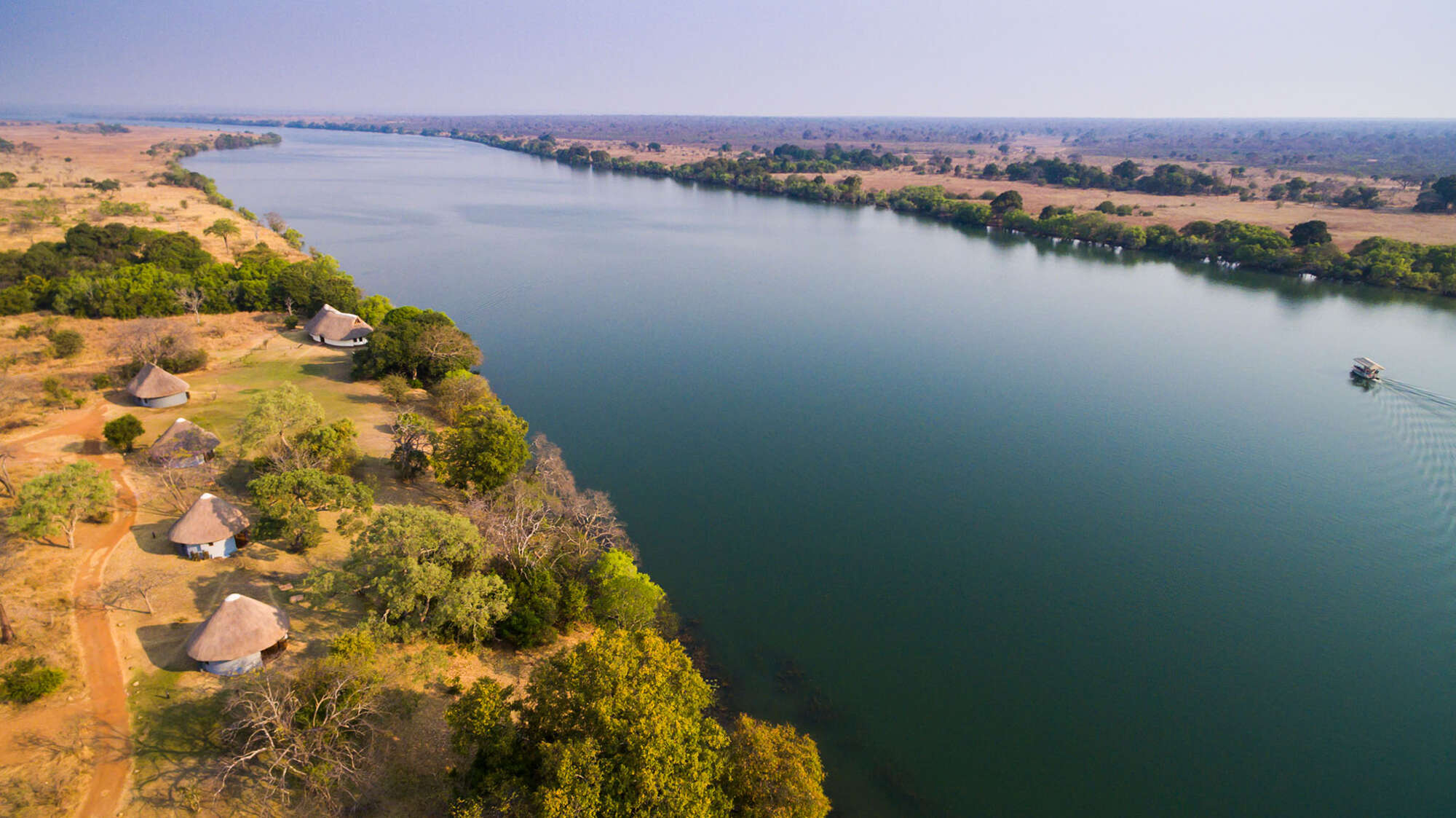
Mukambi Safari Lodge
Mukambi Safari Lodge is a solidly built, comfortable property just off the main road from Lusaka, making it one of the most convenient camps in Kafue.
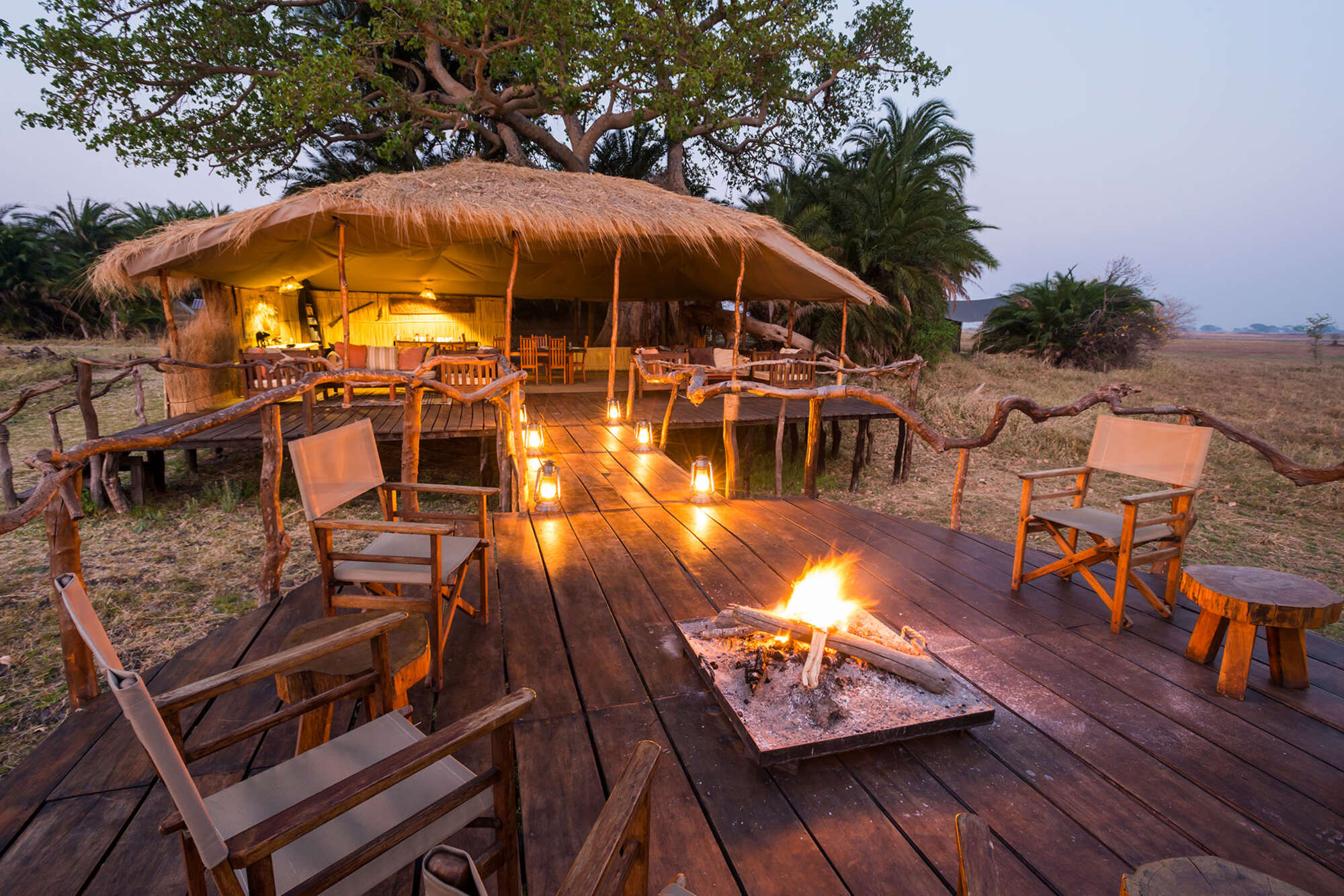
Mukambi Plains Camp
Mukambi Plains Camp is a rustic, tented property located in the middle of the vast Busanga Plains in Kafue National Park.
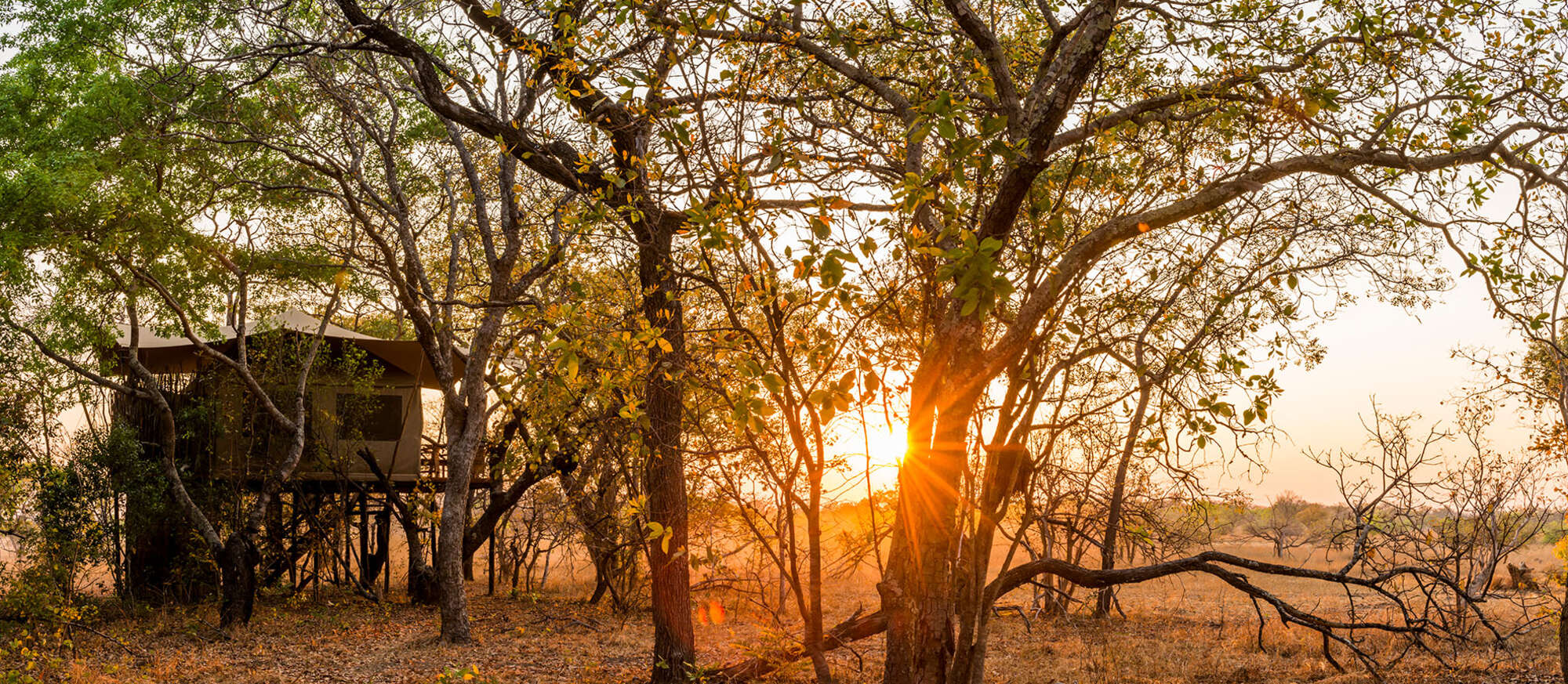
Fig Tree Camp
Fig Tree camp is in the centre of Kafue National Park, and in addition to having a stunning location is well placed to start or end your trip in the park.
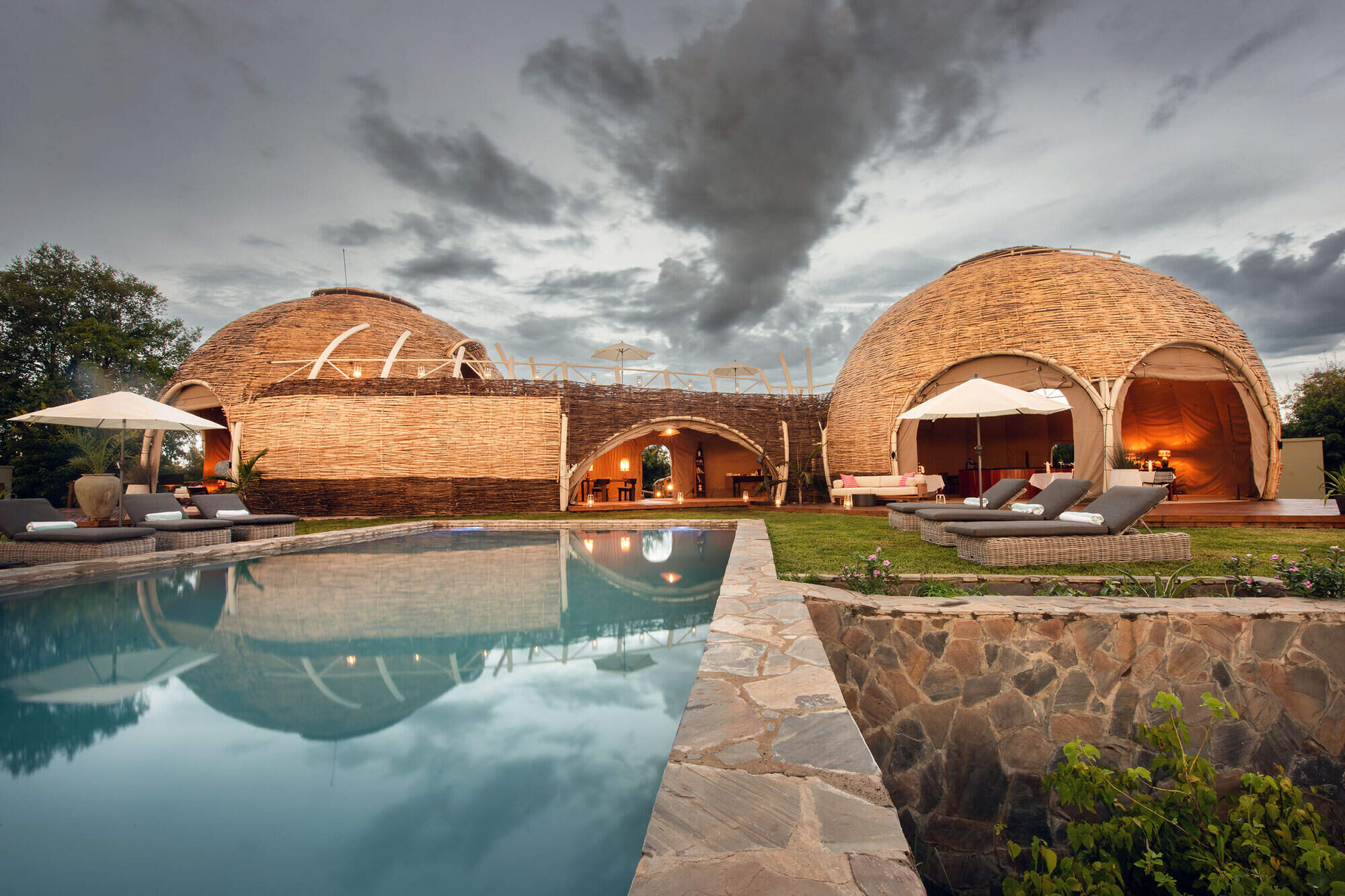
Ila Safari Lodge
Ila Safari Lodge is a comfortable lodge just outside Kafue National Park, with convenient access from Lusaka.
Our travellers’ wildlife sightings in Kafue
Whenever our travellers set off for Kafue National Park, or to any other safari destination, we ask them to consider keeping a record of their key wildlife sightings.
Many find that this adds an extra dimension to their trip, while their feedback gives us unparalleled and growing information on where and when you are likely to see individual species.
Elephant in the Kafue, for example, have in recent years tended to congregate in certain areas, but the more we know about this, the more we can understand - and the more we can advise future travellers.
Click on a species below for more information on the top locations in Kafue for wildlife sightings, or see our interactive map showing the best locations for individual wildlife species in Zambia. Read how this wildlife survey works.

98% success

93% success

86% success

68% success

58% success

55% success

54% success

52% success

32% success

23% success

17% success

11% success

6% success

6% success

2% success

0% success
When to go to Kafue National Park
Kafue National Park has distinct wet and dry seasons.
The wet season (November to April) brings lush vegetation and abundant birdlife but challenging game viewing due to dispersed wildlife and limited access.
The dry season (May to October) offers prime wildlife viewing as animals gather around water sources. June to September provide ideal safari conditions with pleasant temperatures and excellent visibility. October can be extremely hot, while May and November are ‘transition’ months.
Click on the months below for the pros and cons of visiting Kafue in each month.
Jan
Feb
Mar
Apr
May
Jun
Jul
Aug
Sep
Oct
Nov
Dec
Kafue National Park in January
January marks the peak of Kafue National Park's wet season. Expect frequent heavy downpours, often lasting for hours, punctuated by brief sunny intervals. The mercury soars above 30°C/86°F, accompanied by high humidity.
The park's landscapes are verdant and lush, with crystal-clear air. However, the abundance of water causes wildlife to disperse, and thick vegetation can hinder sightings. Migratory birds boost the park's avian diversity. Many areas of Kafue become inaccessible as seasonal rivers flood and dirt roads turn impassable. Only a few lodges, near all-weather roads in the centre of the park, remain operational. Visitor numbers are low, and accommodation options offer their most competitive rates.
- Wet season peak: frequent showers, steamy conditions
- Most lodges shut, verdant scenery ideal for photos
- Wildlife scattered, challenging to spot in thick foliage
- Minimal tourists, budget-friendly rates available
- Lush greenery dominates the landscape
Our view
This is not a great time to visit
Weather in January
Kafue National Park in February
February continues the wet season trend in Kafue National Park. Dramatic thunderstorms deliver brief but intense rainfall most days, interspersed with clear, sunny periods.
The park remains awash with water, dispersing wildlife and limiting access to certain areas. Dense vegetation restricts game viewing and walking safaris, but swollen rivers allow for unique boating experiences in some parts of the park. As the month progresses, water levels in the park's rivers begin to rise noticeably. The few operational camps continue to see low visitor numbers and offer reduced rates.
- Continued wet season: daily downpours, muggy atmosphere
- Majority of safari lodges and camps closed for the season
- Verdant surroundings, but wildlife sightings limited
- Rivers in flood and excellent for bird-watching
- Scarce visitors, economical pricing for adventurers
Our view
This is not a great time to visit
Weather in February
Kafue National Park in March
March signals the final month of Kafue's rainy season, with heavy showers still common. Water levels peak, making navigation within the park challenging. Daytime temperatures consistently exceed 30°C/86°F, with rain-induced humidity remaining high.
Most camps are still closed, and thick vegetation continues to limit wildlife viewing and walking safaris. However, this is a prime time for observing animals with their young, and predator activity can be high. The combination of clear air and increasingly frequent blue skies creates excellent conditions for photography. Birdwatching remains exceptional as migratory species prepare for their winter journey.
- Wet season climax: regular showers, high humidity
- Abundant newborns, but animals hard to spot in greenery
- Few tourists, low-season rates at lodges
- Lush vegetation persists across Kafue
- Most lodges remain closed
Our view
This is not a great time to visit
Weather in March
Kafue National Park in April
April marks a transition in Kafue National Park as the rains shift from intense downpours to lighter, sporadic showers. The landscape remains lush and green, but large wildlife sightings are still limited.
Most safari camps still remain closed; only those central camps near all-weather roads have reliable access. The park's rivers and wetlands are at their fullest, creating a picturesque setting. Despite improving conditions, game viewing can still be challenging due to the dense vegetation.
- Rainy season waning: occasional showers, humid days
- Many bush roads are still impassable
- Verdant scenery continues, wildlife viewing improving
- Most safari camps and lodges remain closed
- Low visitor numbers; attractive low-season rates
Our view
This is not a great time to visit
Weather in April
Kafue National Park in May
May typically heralds the start of the dry season in Kafue. While occasional showers may occur, most days are clear and sunny. As winter approaches, temperatures begin to drop, with daytime highs around 26°C/79°F.
The drying landscape improves access throughout the park, and some camps reopen – though access across the Busanga Plains remains challenging. Standing water is still prevalent, but game viewing noticeably improves as the vegetation thins. The month's end can be popular with visitors taking advantage of pleasant weather, better wildlife sightings, and the last of the low-season rates at many camps.
- Dry season onset: clearer skies, pleasant temperatures
- Many safari camp and lodges now operational
- Landscape still green, excellent for photographers
- Wildlife sightings improving as vegetation thins
- Final month for off-season lodge rates
Our view
A good time to visit, with pros & cons
Weather in May
Kafue National Park in June
June in Kafue National Park sees virtually no rainfall and a high likelihood of consistently sunny days. Humidity drops significantly, and winter's approach brings cooler temperatures, with nighttime lows around 10°C/50°F and daytime highs of 25°C/77°F.
The landscape remains relatively lush, but thinning vegetation greatly enhances visibility for game viewing. The park's rivers and wetlands start to recede, leading more wildlife to appear around the remaining water sources. Even the camps on the Busanga Plains are usually operational by June. Some still offer shoulder season rates, whilst others begin charging peak season prices.
- Consistently sunny days, cooler nights setting in
- All Kafue lodges open and welcoming visitors
- Wildlife viewing noticeably better, animals more visible
- Lovely conditions for walking safaris in Kafue
- Almost all tracks now passable, even on the Busanga Plains
Our view
A very good time to visit
Weather in June
Kafue National Park in July
As the dry season progresses in Kafue, vegetation continues to thin and water becomes scarcer. Wildlife begins to cluster around major water sources, improving game viewing opportunities.
July marks the heart of winter, with daytime temperatures in the 20s Celsius/70s Fahrenheit , but nighttime lows can drop to single digits. Early morning and late evening game drives can be particularly chilly, with camps often providing blankets and hot water bottles. Visitor numbers increase significantly, and popular small camps can fill up quickly. Properties now charge high season rates. The floodwaters in the Busanga Plains have receded to the north, opening up further areas for exploration.
- Warm days, chilly nights: bring layers for comfort
- Wildlife congregating near water sources, easier to spot
- Walking safaris popular, vegetation less dense
- End-July is the start of the busy season
- Lodge and camp rates now at peak season rates
Our view
A very good time to visit
Weather in July
Kafue National Park in August
By August, Kafue's vegetation has significantly thinned and wildlife congregates around remaining water sources, offering excellent game viewing opportunities. Rain is rare, with sunny days almost guaranteed, though dust and smoke can create a haze on the horizon.
Temperatures climb into the 20s Celsius/70s Fahrenheit the day, but dip below 5°C/40°F during nights which feel very cold. Warm clothing (hats and gloves!) is essential for morning and evening activities. One of the most popular months to visit Kafue so safari camps charge peak rates and availability can be limited, especially in sought-after locations.
- Very dry conditions, warm days but cold nights
- Excellent wildlife viewing
- Slight haze may affect long-distance photography
- Perfect weather for walking safaris in the park
- Peak season: lodges at high season rates
Our view
Fantastic: the very best time to visit
Weather in August
Kafue National Park in September
September is arguably the prime time to visit Kafue National Park. Rainfall is virtually non-existent, humidity is low, and temperatures begin to rise. Morning game drives become more comfortable with daytime highs typically in the low 30s Celsius/80s Fahrenheit; nights are less bitter.
Water scarcity concentrates wildlife around remaining sources, providing excellent viewing opportunities and increased chances of inter-species interactions. The wildlife on the Busanga Plains reaches its zenith as safari camps charging peak rates are often full – often having been booked up well in advance. A noticeable haze can affect distant views and photography.
- Dry, hot days with clear skies and mild nights
- Prime time for wildlife viewing in Kafue
- Often dense wildlife on the Busanga Plains
- Dusty conditions may create hazy landscapes
- High season continues, lodges often fully booked
Our view
Fantastic: the very best time to visit
Weather in September
Kafue National Park in October
October sees Kafue at its driest, with the landscape appearing barren and brown. Occasional showers may occur as the promise of the wet season looms. Temperatures can soar above 40°C/104°F during the day, rarely dropping below 20°C/68°F at night.
A smoky, dusty haze can be seen in distant photographs, even obscuring the horizon. The scarcity of water leads to great competition at remaining sources, with excellent opportunities to observe predator-prey interactions. Game viewing is at its peak, though the animals are feeling the stress of the dryness. Most smaller, more remote camps, and all of those on the Busanga Plains, close at the end of October.
- A prime month for wildlife viewing
- Lots of ‘fishing parties’ of birds feeding in drying pools.
- Very hot days and nights, rain unlikely
- Landscape increasingly dusty and harsh
- Hazy conditions may impact photography
Our view
A very good time to visit
Weather in October
Kafue National Park in November
November typically marks the transition from dry to wet season in Kafue – which makes this month unpredictable. Temperatures remain high and humidity builds until it rains. Spectacular thunderstorms then increase in in frequency later in the month, triggering rapid green growth.
Wildlife begins to disperse as water becomes more readily available. Increasing numbers of migratory birds arrive and antelope species gathering for calving. Most more remote camps are closed, including those on the Busanga Plains; camps remaining open reduce their rates. With the rains comes crystal-clear air – perfect photographic conditions.
- Transition from dry to wet season begins
- Wildlife viewing declines as animals disperse
- Landscape turns green, everything comes alive
- Clearer air means better photographic conditions
- Lodge rates decrease; most safari camps close
Our view
A good time to visit, with pros & cons
Weather in November
Kafue National Park in December
December usually sees Kafue fully in the grip of the wet season. Heavy thunderstorms occur on most days, interspersed with sunny periods. Temperatures begin to drop but still exceed 30°C/86°F during the day, accompanied by high humidity.
The rainfall transforms the landscape, encouraging lush vegetation growth. While wildlife remains in the park, sightings become more challenging due to the thick foliage and dispersed animal populations. Many areas become difficult to access, and all but a few centrally located camps close for the season. Open camps offer their lowest rates. The rains clear the air, restoring vivid blue skies that delight photographers.
- Rainy season in full swing: hot, humid, wet days
- Wildlife harder to spot as vegetation thickens
- Many Kafue lodges close; others offer low-season rates
- Green landscape and clear air perfect for photography
- Many birds in breeding plumage
Our view
This is not a great time to visit
Weather in December
Kafue National Park: In Detail
A guide to Kafue National Park
Covering some 22,400km2, Kafue National Park falls into two halves, divided by a tarmac road, but defined throughout by the permanent Kafue River as it flows south towards the man-made Lake Itezhi-Tezhi - which itself borders the east side of the park.
For a safari, the north of the park is the most popular, an undulating plateau veined by tree-lined tributaries of the main Kafue River. Within this, the Busanga Plains are a particular highlight, its lush vegetation proving irresistible to huge herds of antelope, as well as buffalo, zebra and wildebeest – pursued by lions, cheetah and wild dogs.
With generally drier vegetation, the southern Kafue is less attractive to large herds of game, except alongside the Kafue River itself. South of Lake Itezhi-Tezhi, elephants tend to cluster around the park headquarters at Ngoma, while further south again is the vast expanse of the Nanzhila Plains.
Safaris to Kafue National Park
Most of Expert Africa’s trips take the fly-in approach. Getting to Kafue by air is certainly one of the most relaxing, especially if your time is relatively limited, or you like the idea of a safari holiday here rather than an expedition. There are no scheduled flights into the park, but several charter companies will fly you in or out on request. There is also a well maintained tarmac road between Lusaka and the Kafue, which means road transfers to camps in the centre of the park (approximately 4 hours) are also a realistic option, which can be considerably cheaper than chartering a plane.
Environment of Kafue National Park
Travelling from the north of the park to the south, you can see the landscape transform from flat open grasslands to miombo woodland interspersed with huge granite hills.
The permanent Kafue River also transforms as it makes its way through the park, starting as a wide sluggish channel in the north, and changing to rapids crashing around hundreds of granite boulders in the south before emptying into the man-made Lake Itezhi-Tezhi.
Surrounding the whole area are no fewer than nine game management areas (GMAs), which provide a valuable buffer zone for the park’s wildlife.
Northern Kafue: the Busanga Plains
In the far north of this sector, the Lufupa River flows into the Busanga Swamps. During the rains, this floods out over the adjacent Busanga Plains; when the waters recede, they leave behind a carpet of lush vegetation that is irresistible to many herbivores.
These flat plains are dotted with photogenic “islands” of wild date palms, sausage trees and fig trees. You'll often also find huge herds of red lechwe and puku, as well as buffalo, zebra, wildebeest and other antelope.
The prides of lion residing here are known for their tree-climbing antics; it's Zambia's best area for cheetah and one of its best for wild dogs, and is certainly the best game area in Kafue National Park.
The south side of Kafue National Park
The southern half of the park is perfect for those who love exploring, and a little patience can be rewarded with some fantastic game viewing. With such a vast area to explore, and a low number of visitors, the southern Kafue offers a great safari experience for those who value a true feeling of wilderness as much as the game-sightings.
Wildlife of Kafue National Park
Rarely far away are lion, which are relatively widespread in Kafue National Park - and on the Busanga Plains, prides stalk nightly through nervous herds of puku and lechwe. Similarly widespread and regularly - if not often - seen are spotted hyena.
Leopard are common in all the main forested areas, whereas cheetah are most frequently sighted on the open plains of the northern Kafue, where they seem to be thriving. Occasional sightings of wild dogs occur all over the park.
Although elephant thrive throughout the park, they congregate in greater numbers in the south. buffalo, too, favour this area - though not to the exclusion of the north - and hippos are of course attracted to the perennial rivers.
Birdlife of Kafue National Park
The wetlands and floodplains have the full range of herons (including the black heron), storks and ibises, plus crowned and wattled cranes. Denham's (or Stanley's) and kori bustards occur, along with secretary birds, and geese (spur-winged and Egyptian) by the thousand.
Long, verdant stretches of riverine vegetation harbour Ross's turaco, Narina trogons and olive woodpecker, while on the river itself you may be treated to a sighting of the African finfoot, or a nesting colony of African skimmers.
Relative rarities inhabit Kafue’s extensive miombo woodlands, from the pale-billed hornbill and Sousa's shrike to Chaplin’s barbet, one of Zambia’s two endemic birds. The other - the black-cheeked lovebird - is relatively common in the south, on the Nanzhila Plains.
Map of Kafue National Park
A quick glance at our Kafue National Park maps shows that the park is neatly divided in two by a tarmac road that runs west from Lusaka, a drive of around four hours. A cluster of lodges lines this road, making it a good jumping off spot to explore the park, or for a short stopover.
For these and other places to stay in Kafue National Park, click on the orange markers, and follow the links to read more details and reviews. Scroll in for a feel for the rivers that bring life to this vast wilderness; scroll out to reveal the sheer scale of this under-visited park - and its location due north of Livingstone and the Victoria Falls.
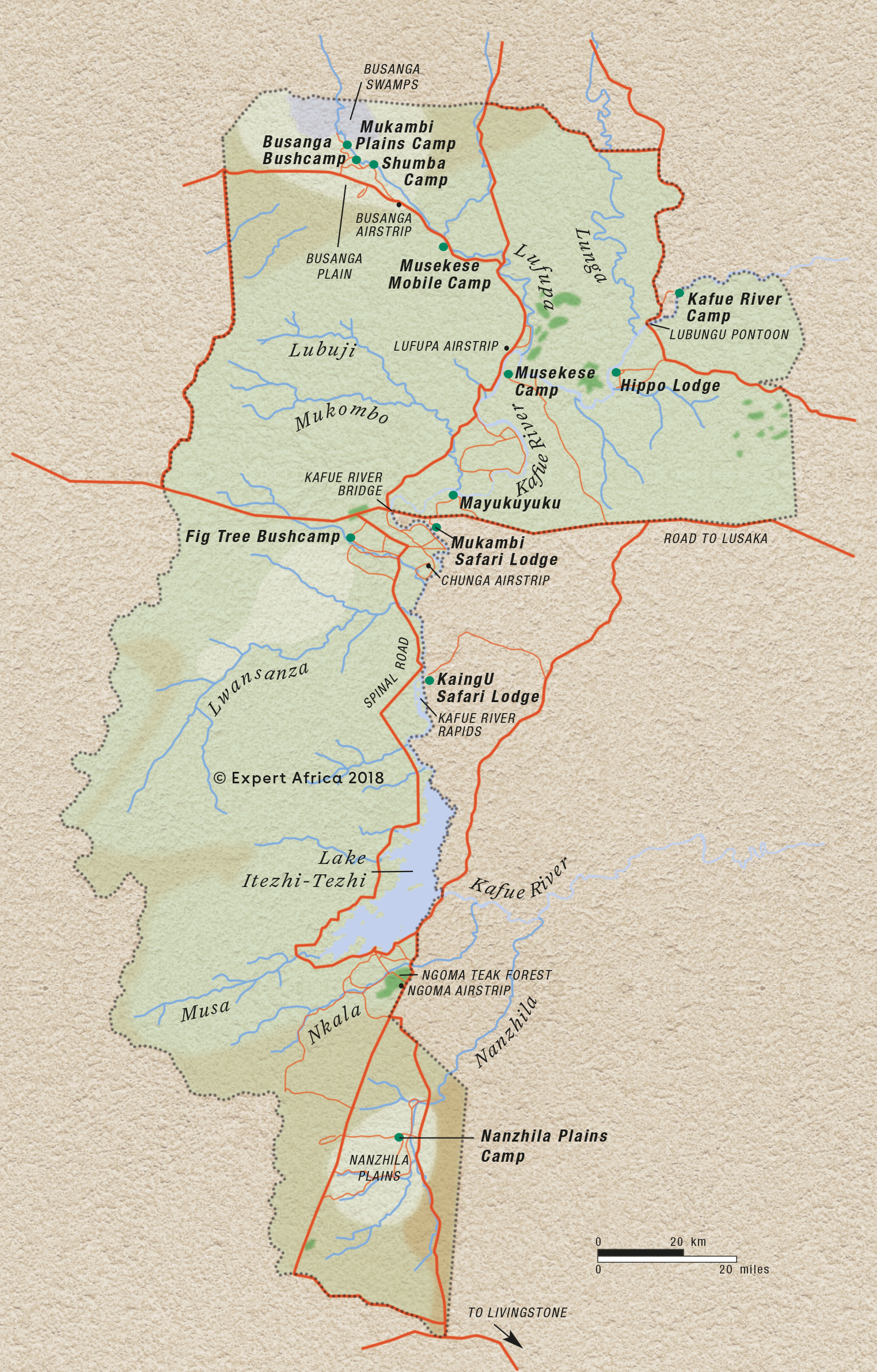
Ideas for safari holidays in Kafue National Park
From the rich range of possibilities, we have put together a couple of suggestions for a Kafue National Park safari, both incorporating the wildlife-rich Busanga Plains but also casting the net further so that you can get a real feel for the park’s diversity.
Perhaps you’d like to focus on one place, or to indulge in a hot-air balloon ride; take a leisurely cruise on the Kafue, or even paddle an inflatable canoe. There are plenty of options.
As all our trips are tailormade, contact us and we will help you to create a Kafue safari that fits around you.

Purple Roller Safari
8 days • 2 locations
LUSAKA AIRPORT TO LUSAKA AIRPORT
Explore the varied habitats and terrain of Kafue National Park with stays in two wonderfully remote bushcamps: sister camps that offer access to both the centre of the park and the wildlife-rich Busanga Plains.
US$9,320 - US$9,320 per person

Defassa Waterbuck Safari
9 days • 3 locations
LUSAKA AIRPORT TO LUSAKA AIRPORT
Stay in three intimate, owner-run camps during this exploration of Kafue National Park. Remote locations, true wilderness and a range of activities make for a real adventure off the beaten track.
US$9,350 - US$9,360 per person
Our top 10 lodges and safari camps in Kafue National Park
While many Kafue safari lodges have been in operation for years, others are relatively new, yet all are intrinsically involved with the park, its wildlife, and its conservation.
From the Kafue accommodation available, we have selected just a handful of game lodges, based on their location, their standards of guiding and accommodation, and our experience of each camp.
To the north, visitors will find a clutch of camps on the Busanga Plains, each unique - yet each very welcoming. Among these are Busanga Bush Camp, Musekese, Mukambi Plains, Chisa Busanga Camp and Shumba, with - a little further south - the new Ntemwa Busanga.
In the centre of the park, with easy access by road, are the long-established Mukambi Safari Lodge, along with the newer Fig Tree Camp and Ila Safari Lodge, while to the south, KaingU Lodge is ideal for exploring the boulder-strewn Kafue River as it broadens on its way to the Itezhi-Tezhi Dam.

Musekese Camp
Musekese is a small owner-run tented camp, offering great guiding and a high degree of personal service in a stunning wilderness area, with modest game.

Busanga Bushcamp
Busanga Bushcamp is a small but comfortable tented bushcamp (max 8 guests) which makes a great base for a wildlife safari to the Busanga Plains.

KaingU Lodge
KaingU Lodge, in the centre of the southern part of Zambia's vast Kafue National Park, is in a great location for exploring this section of the Kafue River

Shumba Camp
Shumba is a high-spec camp built on a tree island in the magical Busanga Plains. It opens in May, when the birdlife is particularly amazing; as the dry season progresses, the game can become remarkable.

Ntemwa Busanga Camp
Ntemwa Busanga Camp is a simple but comfortable camp on the southern tip of the Busanga Plains which combines well with its sister camp, Musekese.

Chisa Busanga
Opened in mid 2021, Chisa Busanga Camp is a beautifully designed, small, intimate and rustic camp.

Mukambi Safari Lodge
Mukambi Safari Lodge is a solidly built, comfortable property just off the main road from Lusaka, making it one of the most convenient camps in Kafue.

Mukambi Plains Camp
Mukambi Plains Camp is a rustic, tented property located in the middle of the vast Busanga Plains in Kafue National Park.

Fig Tree Camp
Fig Tree camp is in the centre of Kafue National Park, and in addition to having a stunning location is well placed to start or end your trip in the park.

Ila Safari Lodge
Ila Safari Lodge is a comfortable lodge just outside Kafue National Park, with convenient access from Lusaka.

Looking for inspiration on where to travel next?
Visit our trip chooser to explore your options and find inspiration for your perfect African adventure
Inspire meFrequently Asked Questions
Kafue National Park FAQs
As with any holiday, questions tend to crowd in at the planning stage, and even the most obvious points can be overlooked.
In this section we have tried to answer some of these questions, from where exactly is the Kafue, and how you get there, to whether or not Kafue National Park is a good place for a family safari in the Kafue, and how to explore the park by boat.
Where exactly is Kafue National Park?
East of the park, a drive of some 3–4 hours, is the Zambian capital, Lusaka; to the north is the industrial heartland of Zambia and to the south are the Victoria Falls on the mighty Zambezi River - a charter flight from Livingstone takes around two hours. Despite its size, the heart of this national park of vast plains, rivers and dense forests is surprisingly accessible.
How do you get to Kafue National Park?
Cheaper than chartering a plane is to drive into one of the camps in the centre of the park, a journey of around four hours on a good tarmac road from Lusaka.
Most of those driving themselves in opt to stay in the centre of the park. To explore further a 4WD is essential, ideally on a guided safari rather than self-drive.
Is Kafue National Park good for a family safari holiday?
Some of the Kafue’s safari lodges are sufficiently small that a larger family group could find themselves in exclusive residence, with plenty of activities to choose from. Alternatively, consider a mobile safari, when you and your family will have the chance to experience the wilderness from an even more natural perspective. Whatever your choice, do be aware that anti-malarials are essential.
Can I go on a boat trip in Kafue National Park?
In the centre of the park, drifting down the wide Kafue River at sunset from one of the lodges is to be accompanied by a constantly changing panorama of elephants, puku, and a plethora of colourful birds.
Further south, at KaingU, taking to the river at dawn is to see a light foam on the surface, a natural phenomenon that dissipates as the day advances. Here, small islands break the flow of the river as it rushes around giant boulders, with countless birds in attendance. For the more adventurous, there’s even the option of paddling in an inflatable canoe.
Other areas in Zambia
A safari in Kafue National Park can be complete in itself, but it also combines well with Zambia's top-class South Luangwa National Park and Lower Zambezi National Park.
If walking is your priority, consider the North Luangwa, whose handful of small camps are focused on exploring this little-visited park on foot. And if even this isn't sufficiently remote, Liuwa Plain National Park is a must.
Big game aside, Zambia has some extraordinary wildlife surprises up its sleeve, from the fruit bat migration in Kasanka National Park to the extraordinary shoebills of the Bangweulu Wetlands. Then you can hike in total privacy at Mutinondo Wilderness, or come face to face with an English stately home in the bush at Shiwa Ng'andu. And for many, the icing on the cake is the majesty of the Victoria Falls.
